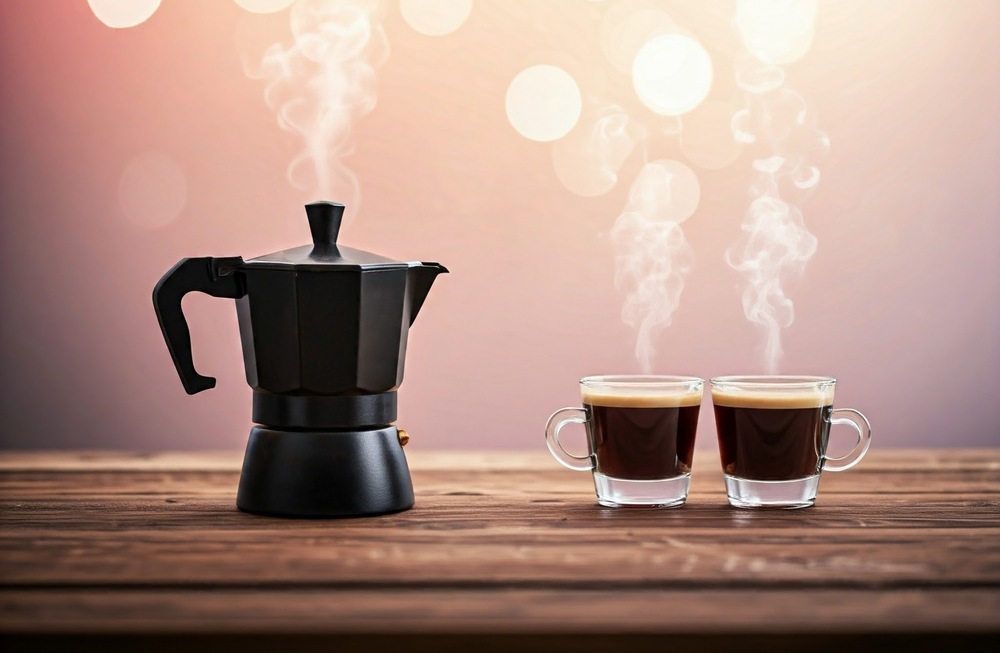

The Moka pot is one of the most iconic objects associated with the ritual of coffee in Italy. Invented in 1933 by the ingenious Alfonso Bialetti, the Moka quickly became a symbol of Italian craftsmanship and the go-to method for brewing coffee at home. Its simple yet brilliant design has won over millions of Italian households and coffee enthusiasts worldwide, making it a staple in kitchens and a true emblem of Italian coffee culture.
A symbol of italian innovation and design
Alfonso Bialetti had the foresight to create a quick and easy way to brew coffee, drawing inspiration from the pressure-based washing machines of the time. This led to the creation of the Moka Express, made from aluminium for its lightweight properties and excellent heat conductivity. The octagonal shape was not just an aesthetic choice but a practical one—it ensures even heat distribution and prevents warping over time. Since its invention, the Moka has become a global icon of home coffee culture, synonymous with quality and tradition.
How to make a great coffee with a moka pot: myths and truths
Brewing the perfect cup of coffee with a Moka pot requires attention to detail and a few expert tricks. Let’s explore how to avoid common mistakes and achieve the best results:
1. Cleaning the moka pot
One of the biggest myths is that the Moka pot should never be washed. However, leaving coffee residues and oils inside the pot can lead to rancidity, which imparts an unpleasant taste to your brew. Think of it as a “coffee pan” and clean it every 3-4 days using mild, unscented detergents—avoiding citric acid or vinegar, as these can corrode the aluminium.
2. Water quality and quantity
Water is a key element in coffee extraction. It’s best to use filtered or low-mineral water, avoiding tap water that is high in limescale. Fill the boiler up to the safety valve and no further, as excess water can disrupt the air-to-water ratio, compromising the extraction process.
3. Coffee grind size
The coffee grind for a Moka pot should be coarser than espresso but not too coarse. Grind size is crucial for balanced extraction: if too fine, the coffee will be overly bitter and dense; if too coarse, the result will be under-extracted and weak. The best approach is to grind the coffee fresh using a manual or electric grinder to preserve its aroma.
4. Levelling the Coffee Grounds
Avoid creating a “mound” or tamping the coffee in the filter. Instead, fill the filter up to the rim and gently level it with a knife or by giving it a light shake. This ensures proper water flow through the coffee grounds.
5. The Flame: Slow and Steady
A common mistake is brewing coffee over high heat. This leads to rapid and uneven extraction, overheating the coffee. Use a medium-low flame and wait patiently for the water to rise gradually. As soon as the coffee starts emerging, turn off the heat before hearing the classic gurgling sound this prevents the coffee from burning.
6. Stir and Serve
Before serving, stir the coffee in the upper chamber with a teaspoon to evenly distribute the aromatic compounds.
The new moka pots with competition filters: E&B Lab’s Innovation
Traditional Moka pots have been reimagined and improved by companies like E&B Lab, which has developed innovative “competition” filters. Available on Caffelab, these filters feature a higher number of smaller holes (0.2mm compared to the traditional 0.8mm). This enhances extraction, reduces the presence of “fines” (tiny coffee particles), and results in a cleaner, less bitter, and better-balanced cup.
In our tests, using a specialty coffee such as Ethiopia Dadatu Kebel, we noticed a striking difference in taste: coffee brewed with E&B Lab’s Classic Moka was sweeter, with floral and citrus notes, and free from the usual bitterness.
Step-by-step recipe for the perfect moka coffee
Ingredients and Equipment
- 1 quality Moka pot (E&B Lab’s Classic Moka recommended)
- 20g of freshly ground coffee (for a 3-cup Moka)
- Low-mineral or filtered water
- Coffee scale
Method
- Fill the boiler
Pour cold, low-mineral water into the base of the Moka pot, filling it up to the safety valve level. Do not exceed this level to ensure proper extraction and safety. - Prepare the filter
Fill the filter basket with freshly ground coffee without pressing it down. Level gently using the back of a knife. - Assemble the moka
Ensure the filter and gasket are correctly positioned, then securely screw the upper and lower parts of the Moka together. - Brew on low heat
Place the Moka on a medium-low flame. Be patient and let the water slowly rise. As soon as the coffee starts flowing, turn off the heat before it begins gurgling to avoid burning. - Stir the coffee
Before pouring, stir the coffee in the upper chamber with a teaspoon to evenly distribute the extracted flavours. - Serve and enjoy
Pour the coffee into preheated cups and savour the result.
Brewing the perfect Moka coffee is an art that requires care, quality ingredients, and attention to detail. Experiment with E&B Lab’s new Moka pots and competition filters to take your coffee to the next level. Remember: a clean Moka pot is the secret to an impeccable brew!
Discover E&B Lab’s competition filters on Caffelab.com and transform your Moka pot into a professional coffee-making tool!